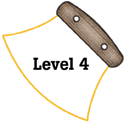
Alaska Science
Key Element B3
 |
Alaska Science |
|
Performance Standard Level 4, Ages 15–18
|
|
|
|
Sample Assessment Ideas
|
|
|
Expanded Sample Assessment Idea
|
|
Procedure Students will:
Reflection and Revision
|
Levels of Performance |
||
|
Stage 4 |
Student work is complete, correct and shows evidence of elaboration and extension. Student uses multiple sources to identify reasonable solutions to the tanning task including Internet research, and local interviews; designed controlled, quantitative experiments. | ||
|
Stage 3
|
Student work is generally complete, correct and shows some evidence of elaboration and extension. Student uses multiple sources to identify solutions to the tanning task including Internet research and local interviews. Although experimentation is included, it may be poorly controlled, lack quantitative measurements or result in a questionable solution to the tanning task. | ||
|
Stage 2
|
Student work is generally on task but shows little evidence of elaboration. Student may use one or two sources to identify solutions to the tanning task. Although experimentation is included, controls and measurements are lacking. Solutions, if included, may not be related to the experimental procedure presented. | ||
|
Stage 1
|
Student work may be related to tanning but is not targeted to identify multiple solutions to the tanning task. Experiments and use of outside information sources, if included, may not be appropriate or useful. | ||
Standards Cross-References
|
||
|
National Science Education Standards Recognize and analyze alternative explanations and models. This aspect of the standard emphasizes the critical abilities of analyzing an argument by reviewing current scientific understanding, weighing the evidence, and examining the logic so as to decide which explanations and models are best. In other words, although there may be several plausible explanations, they do not all have equal weight. Students should be able to use scientific criteria to find the preferred explanations. (Page 175) Scientists usually inquire about how physical, living, or designed systems function. Conceptual principles and knowledge guide scientific inquiries. Historical and current scientific knowledge influence the design and interpretation of investigations and the evaluation of proposed explanations made by other scientists. (Page 176) |
Benchmarks Know why curiosity, honesty, openness, and skepticism are so highly regarded in science and how they are incorporated into the way science is carried out; exhibit those traits in their own lives and value them in others. (Page 287) |
|
Table of Contents | Return to Alaska Native Knowledge Network